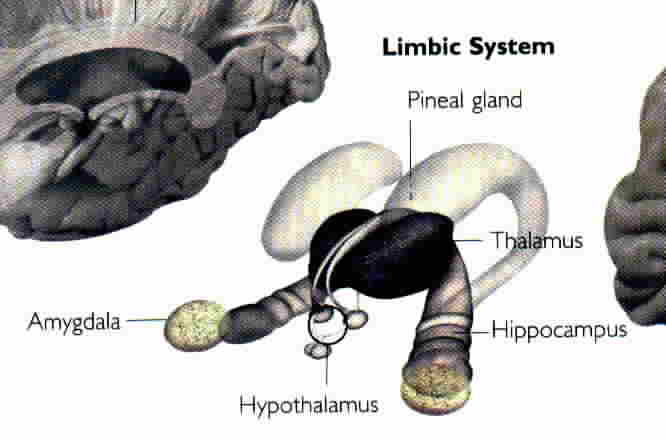
Neuro term. 1. Those interlinked modules and pathways of the brain in charge of emotions, feelings, and moods. 2. The "entire neuronal circuitry that controls emotional behavior and motivational drives" (Guyton 1996:752). 3. The emotional core of the human nervous system (Cytowic 1993).
Usage: A great deal of our nonverbal communication reflects happenings in the limbic system (see, e.g., FACE, MAMMALIAN BRAIN). Nonverbal signs, signals, and cues disclose limbic emotions and attitudes more openly and with greater honesty than words.
Observation. When shopping for consumer products, we often heed limbic rather than rational thought.
Evolution. In human beings, the limbic system grew in tandem with the cerebral cortex (Armstrong, Este [1986]. "Enlarged Limbic Structures in the Human Brain: the Anterior Thalamus and Medial Mammillary Body," Brain Research, Vol. 362, No. 2. pp. 394-97). Thus, ours is the most emotional--as well as the most intellectual--species on Earth.
RESEARCH REPORTS: 1. The limbic system "plays a key role in the evolutionary survival and eventual success of hominids" (Eccles 1989:97). 2. Regarding nonverbal behavior, the limbic system's a. amygdalar division promotes feeding, food-search, angry, and defensive behaviors related to obtaining food; b. septal division promotes sexual pleasure, genital swelling, grooming, courtship, and maternal behavior; and c. thalamocingulate division promotes play, vocalization (e.g., the separation cry), and maternal behavior (MacLean 1993). 3. "While the cortex contains our model of reality and analyzes what exists outside ourselves, it is the limbic brain that determines the salience of that information" (Cytowic 1993:156). 4. The cerebral cortex "has more inputs from the limbic system than the limbic system has coming from the cortex" (Cytowic 1993:161). 5. Many emotional systems, in addition to the limbic system, may exist in the brain (LeDoux 1996:103).
Neuro-notes I. 1. Phylogenetically, the limbic lobe is the oldest part of the cerebral cortex (Willis 1998D:247). 2. The limbic system includes the amygdala, anterior thalamic nucleus, cingulate gyrus, fornix, hippocampus, hypothalamus, mammillary bodies, medial forebrain bundle, prefrontal lobes, septal nuclei, and other areas and pathways of the brain. The hypothalamus, a key player, mediates nonverbal behaviors through the brain-stem reticular nuclei. When excited, the reticular nuclei arouse cerebral as well as spinal circuits. (N.B.: An important two-way link between the limbic system and brain stem is the medial forebrain bundle.)
Neuro-notes II. The limbic system links to mirror neurons through the insula (Iacoboni 2008:117).
Neuro-notes III. (March 28, 2018) We are exploring links between the canine, and human, limbic systems to muscles and nerves in the pelvic wall. Watch this space for findings, in dogs and humans, that bear on the ancient Reproductive Force: "RNA and DNA molecules encode information (via codons) about how to reproduce themselves. Reproduction became a dominant force, joining the four physical forces--gravitation, weak, strong, and electromagnetic--as a fundamental force to be reckoned with. The reproductive force remains a potent motivator in humans today, in their overall demeanor, goals, clothing, automobiles, music, media, art, religion, hairdos, shoes, prom dresses, and diverse additional nonverbal signs, signals, and cues" (Givens 2018: ON THE ORIGIN OF INFORMATION AND ITS COMMUNICATION APART FROM WORDS [http://center-for-nonverbal-studies.org/htdocs/12001.html]).
Neuro-notes IV. Pelvic floor: The emotional limbic system links to the pelvic floor in both canines and humans. In dogs (Canis lupus familiaris), it mediates tail wagging. "A large number of new descending motor pathways to caudal brainstem and spinal cord have been recognized recently. Nevertheless all the new pathways seem to belong to one of three motor systems in the central nervous system (CNS). This survey gives an overview of the pathways belonging to the so-called emotional motor system or the third motor system as defined by Holstege. The similarities and differences with the core, median and lateral paracore areas of the CNS as defined by Nieuwenhuys are discussed" [Holstege, Gert (1992). "The Emotional Motor System." European Journal of Morphology (01 Jan 1992, 30(1):67-79)].
YouTube Video: Watch a 40 second tutorial on the limbic system.Copyright 1998 - 2018 (David B. Givens/Center for Nonverbal Studies)
Detail of illustration from Mapping the Mind (p. 17; copyright Weidenfeld &
Nicolson, London, 1998)